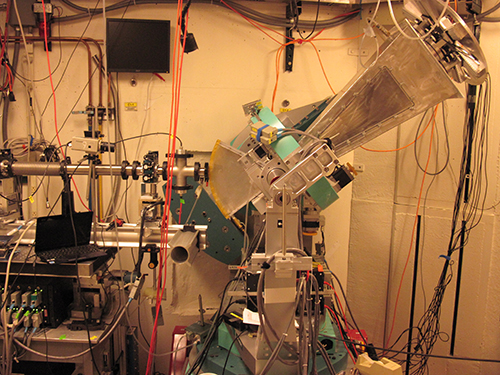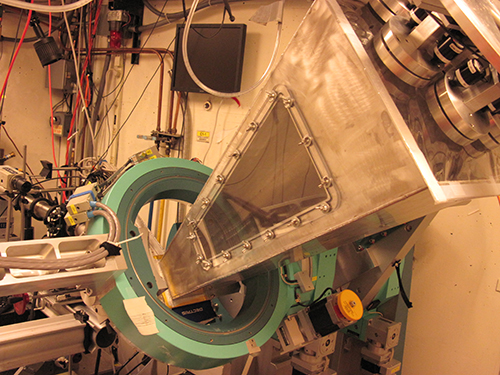X-RAY RUNS: Apply for Beamtime
2017 Nov 1 - Dec 21
2018 Feb 7 - Apr 3
2018 Proposal/BTR deadline: 12/1/17
2018 Apr 11 - Jun 4
2018 Proposal/BTR deadline: 2/1/18
X-ray Raman spectroscopy (XRS) is an inelastic scattering method that allows detection of low energy (<3keV) spectroscopic signatures using high-energy x-rays, typically by exciting core electrons of low-Z elements such as carbon and oxygen. The signals look much like x-ray absorption near-edge spectroscopy (XANES), but the element K-edges (EK) are not otherwise accessible at CHESS. XRS offers possibilities for monitoring light element chemical and physical processes when soft x-rays cannot be used, for example samples at high pressure or during chemical processing. Analyzer crystals are positioned to collect and reflect scattered hard x-ray photons at energy E1 as incident beam energy E0 is scanned in the vicinity of E1 + EK. XRS is weak, so high incident flux (within 1eV bandwidth), and large collection solid angle (at comparable resolution) are essential.
To perform XRS at the Cornell High Energy Synchrotron Source (CHESS), a new spectrometer design was required. Staff scientist Ken Finkelstein, postdoc Katharine Silberstein, operator John Conrad, research support specialist Aaron Lyndaker, and intern Arthur Campello worked together to develop a 7-crystal system with high collection efficiency. The photos show analyzers mounted at the downstream end of the diffractometer arm. The arm can be positioned over a range of scattering angles, to access a range of momentum-transfers. Analyzer position is optimized depending on EK to minimize Compton and other background scattering. An area detector (visible below the flight path in lower photo) images backscattered inelastic signals. The sample, as well as the incident and scattered beams, are in a helium atmosphere to reduce air scattering. In initial experiments, the team tested the new spectrometer by measuring x-ray Raman spectra at K-edges of C in diamond and graphite; B and N in boron nitride; O in copper and zinc oxides; and Mg in magnesium chloride. Samples were prepared by pelletizing powders diluted with an appropriate amount of boron nitride for effective transmission.
This new capability will become an essential tool with wide applications after the CHESS undulator upgrade is completed in 2019. Once components to improve signal/noise have been added to the spectrometer system, users will be able to use it to probe molecules and systems of interest in a variety of sample environments. Users will be able to collect XANES data of light elements with relative ease. With the commissioning of XRS at C1, CHESS will become a destination for spectroscopists desiring information that would otherwise be obtained using soft x-rays in manners that constrain the choice of sample environment.


Two views of the x-ray Raman spectrometer.
Submitted by: Katharine Silberstein and Ken Finkelstein, CHESS, Cornell University
04/12/2016
